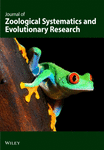Eye reduction and phylogenetic age in ophidiiform cave fish1
Dedicated to Prof. Dr. Dr. h. c. Wolf Herre on occasion of his 80th birthday.
Abstract
The West Indian Ophidiiform fish are characterized by the occurrence of several troglobitic species. They are Ogilbia (=Typhliasina pearsei (Yucatan), Lucifuga subterruneus, L. dentatus and L. simile (Cuba), and L. spelaeotes (Babama Islands). The surface relatives, e.g. Ogilbia spp., prefer lightpoor zones. This is shown by a large lens and a retina almost exclusively consistin of rods. L. dentatus, L. subterraneus, and O. pearsei possess extremely reduced eyes. The eye of L. selaeotes has morphologically an intermediate position. In correlation to varying eye size a different number of rods may be developed. Furthermore in some specimens the lens starts degenerating. Contrar to the extremely reduced cave forms all specimens of L. spelaeotes can still perceive light with tleir eyes. The different degrees of reduction in the West Indian Ophidiiform cave fish probably reflect varying phylogenetic ages. A possible date of origin of L. spelaeotes could be at the beginning or the end of the last glaciation.
The eyes of neonate individuals of the live-bearing L. dentatus and O. pearsei possess a lens and a retina rudiment. No fundamental structural and histological differences between both species were found at this stage.




